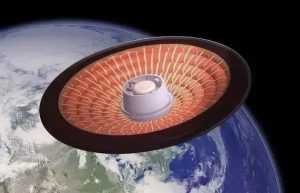Once again, the Shenzhou spacecraft has written a new chapter in China’s space exploration story. On October 30, the Shenzhou 19 carried three astronauts into orbit, beginning their space mission.
Amid the excitement of the Shenzhou 19’s successful launch, the Shenzhou 18 quietly completed its mission and safely returned to Earth. However, sharp-eyed viewers noticed something unusual: the capsule’s exterior appeared scorched black upon return. Why does this happen?
 Why Launching is Different
Think back to the Shenzhou 19 launch: the rocket, blazing like a fiery dragon, ascended majestically into the sky. Despite the intense flames, the spacecraft looked completely unharmed.
The key lies in speed and atmospheric conditions. During launch, although the rocket accelerates rapidly, the spacecraft doesn’t reach speeds that would cause extreme heating. As the rocket climbs higher, the surrounding air grows thinner, reducing friction. By the time the spacecraft reaches space, its speed is around 3 km/s—not fast enough to cause significant heating.
Why Launching is Different
Think back to the Shenzhou 19 launch: the rocket, blazing like a fiery dragon, ascended majestically into the sky. Despite the intense flames, the spacecraft looked completely unharmed.
The key lies in speed and atmospheric conditions. During launch, although the rocket accelerates rapidly, the spacecraft doesn’t reach speeds that would cause extreme heating. As the rocket climbs higher, the surrounding air grows thinner, reducing friction. By the time the spacecraft reaches space, its speed is around 3 km/s—not fast enough to cause significant heating.
 The Return is a Different Story
Reentry is far more intense. The returning capsule is traveling close to orbital velocity—nearly 28,000 km/h (17,500 mph). As it descends into Earth’s atmosphere, the air becomes denser, creating enormous friction. This friction generates extreme heat, with temperatures on the capsule’s surface exceeding 1,000°C (1,832°F). At such temperatures, most materials would disintegrate.
How Does the Capsule Stay Intact?
To protect the astronauts, scientists coat the capsule with a special heat shield made from ablative materials. These materials are designed to:
•Withstand extremely high temperatures.
•Burn and peel away in layers during reentry, carrying excess heat with them.
Inside the capsule, advanced life support systems ensure the astronauts remain safe and comfortable.
Challenges with Current Technology
Although modern heat shields are effective, they come with drawbacks:
•Nearly half the spacecraft’s weight is dedicated to heat protection, limiting cargo capacity.
•The heat shield is expensive and single-use, driving up mission costs.
The Future: Inflatable Heat Shields
To address these challenges, China and the U.S. are developing inflatable heat shields. These innovative shields are compact during launch and expand during reentry, increasing their surface area for better deceleration and heat management. Benefits include:
•Lightweight and cost-effective.
•Reusable, reducing long-term expenses.
However, designing an inflatable heat shield is no small feat. It must deploy flawlessly at high speeds and remain stable under extreme conditions, requiring breakthroughs in materials and engineering.
Progress in China
China has already made significant strides in this area. In 2020, using the Long March 5B rocket, China tested its next-generation crewed spacecraft and a flexible inflatable cargo return capsule. While the tests weren’t entirely successful, they provided invaluable data for future advancements.
The Return is a Different Story
Reentry is far more intense. The returning capsule is traveling close to orbital velocity—nearly 28,000 km/h (17,500 mph). As it descends into Earth’s atmosphere, the air becomes denser, creating enormous friction. This friction generates extreme heat, with temperatures on the capsule’s surface exceeding 1,000°C (1,832°F). At such temperatures, most materials would disintegrate.
How Does the Capsule Stay Intact?
To protect the astronauts, scientists coat the capsule with a special heat shield made from ablative materials. These materials are designed to:
•Withstand extremely high temperatures.
•Burn and peel away in layers during reentry, carrying excess heat with them.
Inside the capsule, advanced life support systems ensure the astronauts remain safe and comfortable.
Challenges with Current Technology
Although modern heat shields are effective, they come with drawbacks:
•Nearly half the spacecraft’s weight is dedicated to heat protection, limiting cargo capacity.
•The heat shield is expensive and single-use, driving up mission costs.
The Future: Inflatable Heat Shields
To address these challenges, China and the U.S. are developing inflatable heat shields. These innovative shields are compact during launch and expand during reentry, increasing their surface area for better deceleration and heat management. Benefits include:
•Lightweight and cost-effective.
•Reusable, reducing long-term expenses.
However, designing an inflatable heat shield is no small feat. It must deploy flawlessly at high speeds and remain stable under extreme conditions, requiring breakthroughs in materials and engineering.
Progress in China
China has already made significant strides in this area. In 2020, using the Long March 5B rocket, China tested its next-generation crewed spacecraft and a flexible inflatable cargo return capsule. While the tests weren’t entirely successful, they provided invaluable data for future advancements.
 Beyond Space Exploration
The success of Shenzhou 18 not only demonstrates China’s growing space capabilities but also inspires curiosity about the unknown. Technologies like inflatable heat shields represent steps toward safer, more cost-effective space exploration.
Moreover, space technology has a direct impact on our daily lives. Navigation systems, weather forecasting, and even telemedicine rely on advances made in space science. Innovations like inflatable heat shields could spur the development of new industries and bring practical benefits to everyday life.
For more updates on cutting-edge technology and exploration, visit dailynewspapers.in.
Beyond Space Exploration
The success of Shenzhou 18 not only demonstrates China’s growing space capabilities but also inspires curiosity about the unknown. Technologies like inflatable heat shields represent steps toward safer, more cost-effective space exploration.
Moreover, space technology has a direct impact on our daily lives. Navigation systems, weather forecasting, and even telemedicine rely on advances made in space science. Innovations like inflatable heat shields could spur the development of new industries and bring practical benefits to everyday life.
For more updates on cutting-edge technology and exploration, visit dailynewspapers.in.
 Why Launching is Different
Think back to the Shenzhou 19 launch: the rocket, blazing like a fiery dragon, ascended majestically into the sky. Despite the intense flames, the spacecraft looked completely unharmed.
The key lies in speed and atmospheric conditions. During launch, although the rocket accelerates rapidly, the spacecraft doesn’t reach speeds that would cause extreme heating. As the rocket climbs higher, the surrounding air grows thinner, reducing friction. By the time the spacecraft reaches space, its speed is around 3 km/s—not fast enough to cause significant heating.
Why Launching is Different
Think back to the Shenzhou 19 launch: the rocket, blazing like a fiery dragon, ascended majestically into the sky. Despite the intense flames, the spacecraft looked completely unharmed.
The key lies in speed and atmospheric conditions. During launch, although the rocket accelerates rapidly, the spacecraft doesn’t reach speeds that would cause extreme heating. As the rocket climbs higher, the surrounding air grows thinner, reducing friction. By the time the spacecraft reaches space, its speed is around 3 km/s—not fast enough to cause significant heating.
 The Return is a Different Story
Reentry is far more intense. The returning capsule is traveling close to orbital velocity—nearly 28,000 km/h (17,500 mph). As it descends into Earth’s atmosphere, the air becomes denser, creating enormous friction. This friction generates extreme heat, with temperatures on the capsule’s surface exceeding 1,000°C (1,832°F). At such temperatures, most materials would disintegrate.
How Does the Capsule Stay Intact?
To protect the astronauts, scientists coat the capsule with a special heat shield made from ablative materials. These materials are designed to:
•Withstand extremely high temperatures.
•Burn and peel away in layers during reentry, carrying excess heat with them.
Inside the capsule, advanced life support systems ensure the astronauts remain safe and comfortable.
Challenges with Current Technology
Although modern heat shields are effective, they come with drawbacks:
•Nearly half the spacecraft’s weight is dedicated to heat protection, limiting cargo capacity.
•The heat shield is expensive and single-use, driving up mission costs.
The Future: Inflatable Heat Shields
To address these challenges, China and the U.S. are developing inflatable heat shields. These innovative shields are compact during launch and expand during reentry, increasing their surface area for better deceleration and heat management. Benefits include:
•Lightweight and cost-effective.
•Reusable, reducing long-term expenses.
However, designing an inflatable heat shield is no small feat. It must deploy flawlessly at high speeds and remain stable under extreme conditions, requiring breakthroughs in materials and engineering.
Progress in China
China has already made significant strides in this area. In 2020, using the Long March 5B rocket, China tested its next-generation crewed spacecraft and a flexible inflatable cargo return capsule. While the tests weren’t entirely successful, they provided invaluable data for future advancements.
The Return is a Different Story
Reentry is far more intense. The returning capsule is traveling close to orbital velocity—nearly 28,000 km/h (17,500 mph). As it descends into Earth’s atmosphere, the air becomes denser, creating enormous friction. This friction generates extreme heat, with temperatures on the capsule’s surface exceeding 1,000°C (1,832°F). At such temperatures, most materials would disintegrate.
How Does the Capsule Stay Intact?
To protect the astronauts, scientists coat the capsule with a special heat shield made from ablative materials. These materials are designed to:
•Withstand extremely high temperatures.
•Burn and peel away in layers during reentry, carrying excess heat with them.
Inside the capsule, advanced life support systems ensure the astronauts remain safe and comfortable.
Challenges with Current Technology
Although modern heat shields are effective, they come with drawbacks:
•Nearly half the spacecraft’s weight is dedicated to heat protection, limiting cargo capacity.
•The heat shield is expensive and single-use, driving up mission costs.
The Future: Inflatable Heat Shields
To address these challenges, China and the U.S. are developing inflatable heat shields. These innovative shields are compact during launch and expand during reentry, increasing their surface area for better deceleration and heat management. Benefits include:
•Lightweight and cost-effective.
•Reusable, reducing long-term expenses.
However, designing an inflatable heat shield is no small feat. It must deploy flawlessly at high speeds and remain stable under extreme conditions, requiring breakthroughs in materials and engineering.
Progress in China
China has already made significant strides in this area. In 2020, using the Long March 5B rocket, China tested its next-generation crewed spacecraft and a flexible inflatable cargo return capsule. While the tests weren’t entirely successful, they provided invaluable data for future advancements.
 Beyond Space Exploration
The success of Shenzhou 18 not only demonstrates China’s growing space capabilities but also inspires curiosity about the unknown. Technologies like inflatable heat shields represent steps toward safer, more cost-effective space exploration.
Moreover, space technology has a direct impact on our daily lives. Navigation systems, weather forecasting, and even telemedicine rely on advances made in space science. Innovations like inflatable heat shields could spur the development of new industries and bring practical benefits to everyday life.
For more updates on cutting-edge technology and exploration, visit dailynewspapers.in.
Beyond Space Exploration
The success of Shenzhou 18 not only demonstrates China’s growing space capabilities but also inspires curiosity about the unknown. Technologies like inflatable heat shields represent steps toward safer, more cost-effective space exploration.
Moreover, space technology has a direct impact on our daily lives. Navigation systems, weather forecasting, and even telemedicine rely on advances made in space science. Innovations like inflatable heat shields could spur the development of new industries and bring practical benefits to everyday life.
For more updates on cutting-edge technology and exploration, visit dailynewspapers.in.







